Excel templates
Overview
In this section, we will create an Excel template using Qlik Sense objects.
To create an Excel template, go to the Templates tab and click Create button. Your screen will look something like this:
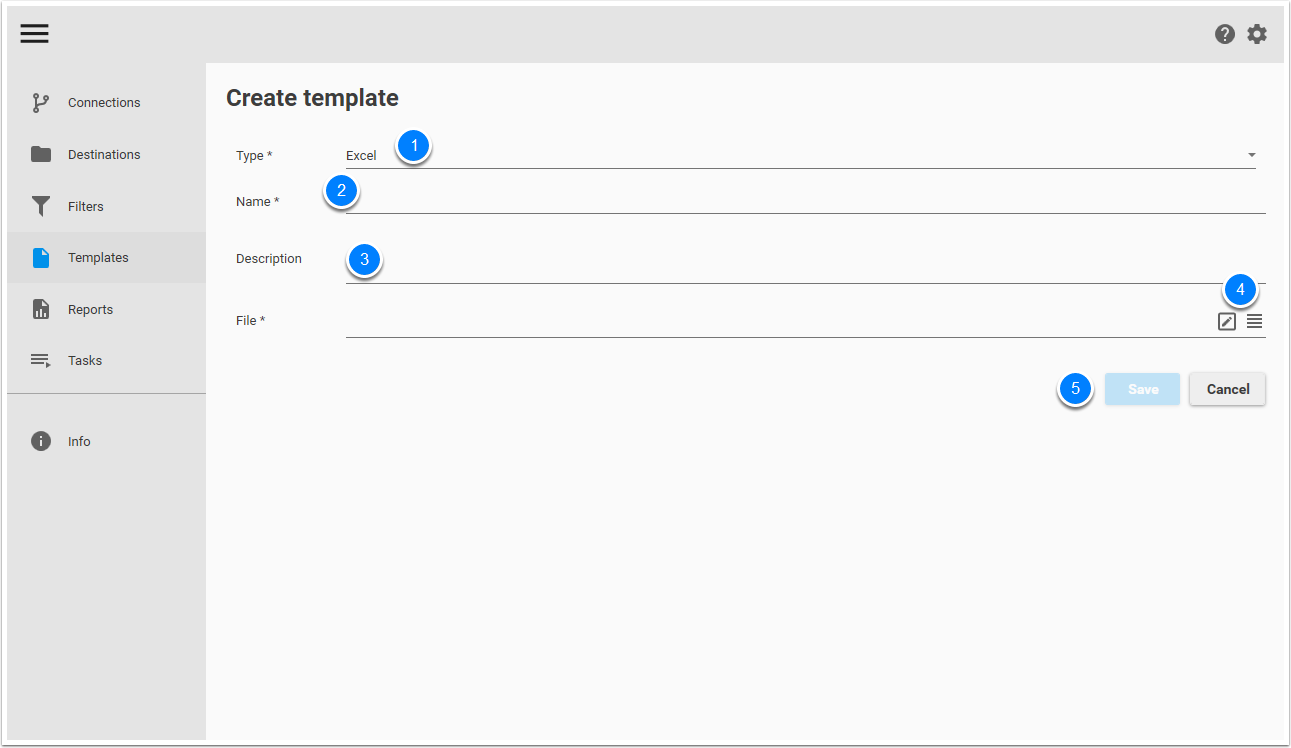
- In the Type drop-down menu, select Excel.
- Give a name to your template. Example: Performance Excel template.
- Add a description (optional).
- You have two options to create a new template. You can click
to create a new Excel file or click
to create your template from an existing Excel file.
- Save your work.
Click to create a new Excel file. Your screen will look something like this:
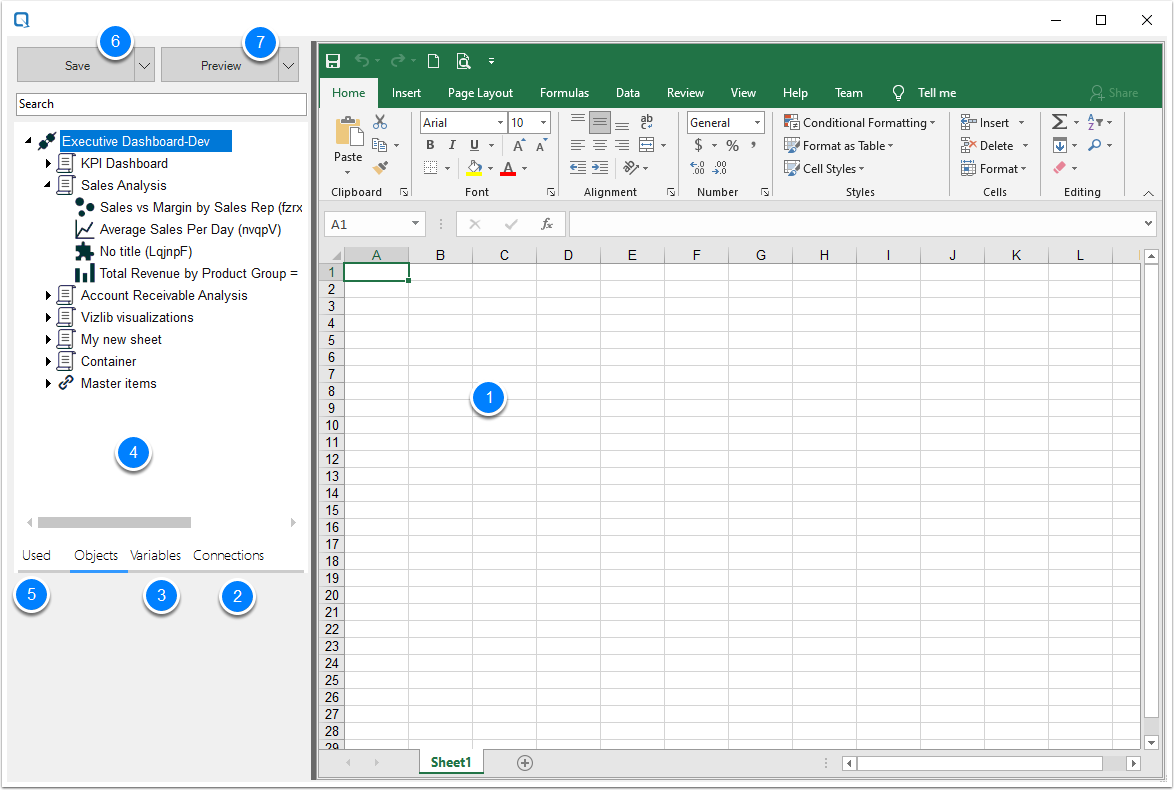
- An Excel file is open in the Qalyptus application.
- Connections: list of the Qlik Sense and QlikView connections created in the Connections page.
- Variables: list of the Qlik variables of the selected connections. Select the ones you want to use.
- Objects: list of the Tables, Charts, and Master Items of the selected connections. Select the ones you want to use.
- Used: here, you will find the objects and variables you want to use in your template.
- Save button allows you to save the template.
- The preview button allows you to have a preview of the report.
Add objects to create the template
After opening the Template Editor, you can begin designing your report.
Step 1: Select Connections
In the Connections tab, select one or multiple connections to use for the report. A connection represents a Qlik Sense application.
Step 2: Select Variables and Objects
To add variables and objects (charts and tables) to the template file, follow these steps:
Navigate to the Objects and Variables tabs to view all available items from the selected connections. The Used tab will display the items you’ve selected to include in the template.
Adding a Variable
- Go to the Variables tab.
- Right-click on the desired variable.
- Click Use the variable.
- Go to the Used tab.
- Drag and drop the variable into the template file.
- Format the variable and adjust its position as needed.
Adding an Object (Chart or Table)
- Go to the Objects tab.
- Expand the sheet containing the object.
- Right-click on the object.
- Choose one of the following options: Use as a table or Use as an image
- Go to the Used tab to locate the added object.
- Adding Objects as Images
- Drag and drop the object into the template file.
- Move and resize the image as needed.
- Adding Objects as Tables
- Drag and drop the entire object or expand it and drag individual columns to the template file.
- Option 1: Export the entire object as it appears in Qlik Sense.
- Option 2 (Recommended): Export individual columns for more granular formatting.
- Formatting Tables. Use Excel formatting options to customize your tables and pivot tables. For example: Change font style and size, adjust cell colors, add conditional formatting.
An object can simultaneously be used both as a table and as an image. Additionally, you can select the same object multiple times as an image or table to apply different configurations.
For example, you can use a pie chart twice as an image: the first instance without any filter, and the second instance with a filter applied to display data from the previous year.
Qlik Sense tables and pivot tables are exported without their original formatting. Qalyptus uses the Qlik Sense API, which does not support exporting tables with formatting. We recommend using Excel's formatting options to customize your exported tables and pivot tables.
Previewing the Report
Preview your report to see how it looks after adding Qlik Sense objects to the template.
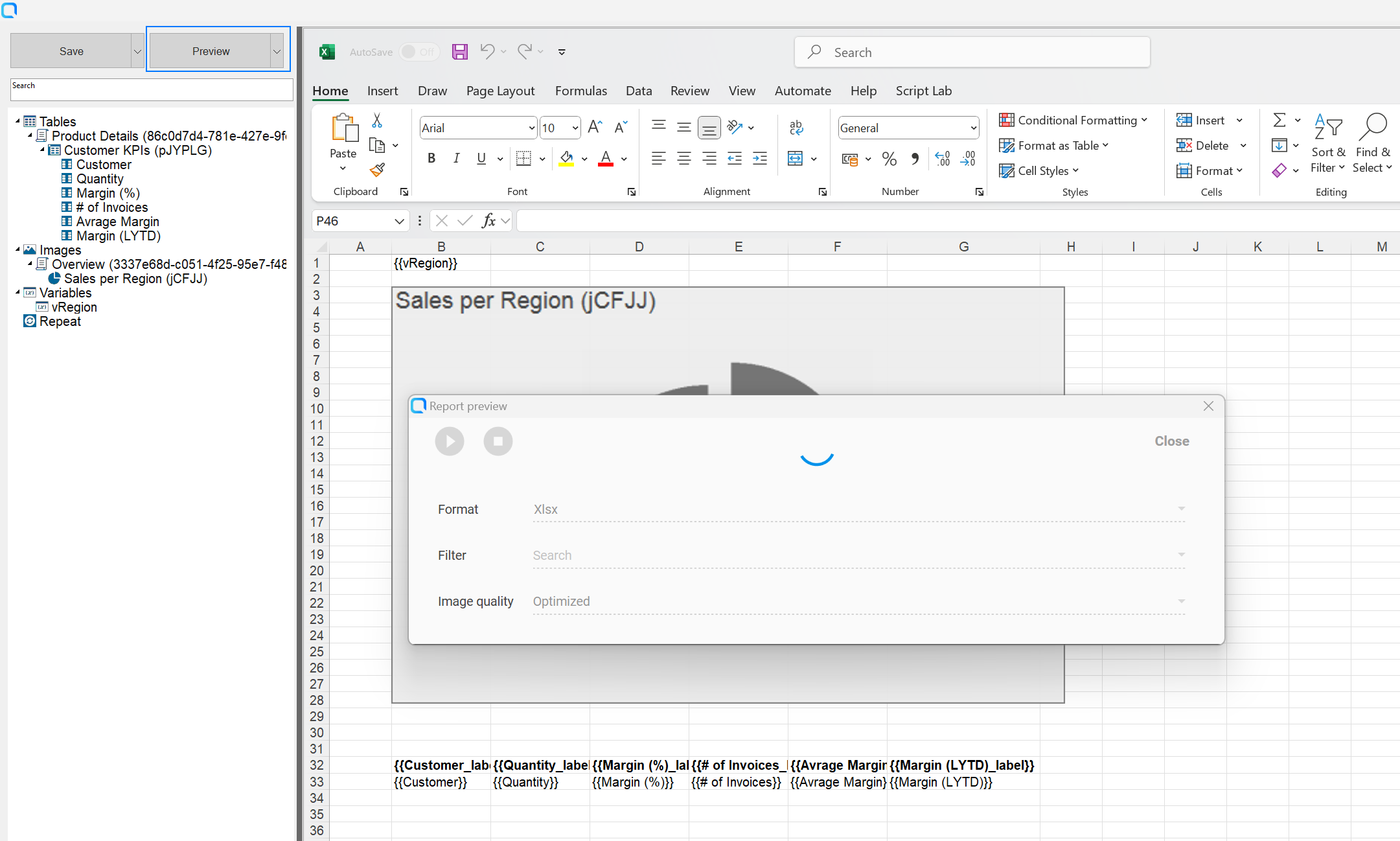
1- Default preview
Click the Preview button to generate the report with default settings:
- Output format: .xlsx
- No filters applied.
- Image quality: Optimized.
- You can stop and restart the generation process at any time.
- Advanced Preview
Click the dropdown menu on the Preview button and select Advanced Preview to customize the report generation:
- Choose the output format.
- Apply a filter at the report level. Filters at the object level will still apply after the report-level filter.
- Set the image quality for all report objects.
- Stop and restart the generation process as needed.
The quality setting in Preview applies only to objects with their image quality property set to Inherited. If an object has a specific image quality setting, that will take precedence.
Third-party objects (extensions) and sheets exported as images will always use Standard image quality. It is not possible to select another option for these items.
Video Tutorial
This short video demonstrates how to use Qlik Sense objects to create a simple Excel template.
Conditional formatting
The table data is exported from Qlik Sense without formatting (normal Qlik Sense API behavior). In the Excel template, you can use the Conditional formatting feature to format the tables exported from the Qlik Sense apps.
In this section, we will see two different options to apply conditional formatting for tables and pivot tables.
1. Column-by-column formatting
If you choose to use a Qlik Sense table or Pivot table in Excel by dragging and dropping its columns, you can add a conditional format for each column.
This option allows you to apply different formats (text color, background color, text size, etc.) for each column.
To format a column, do the following:
- Insert the table or the pivot table columns
- Select a data cell in the column to format
- Click Conditional Formatting
- Add one or many rules to format the column
- After generating the report, Qalyptus will format all the column values.
Here is a video showing an example of conditional formatting for a table column.
Column-by-column formatting is possible only to format a table object or a pivot table that has static columns. By static columns, we mean that the measure columns are not duplicated by using a dimension to the Column area.
You cannot use the column-by-column formatting when the exported columns are dynamic and are not known by Qalyptus in advance.
2. Dynamic formatting
This second method can format a table and any pivot table, a pivot table with static or dynamic columns.
To format a table or a pivot table, do the following:
- Drag and drop the table or the pivot table shortcode
- Select the cell that contains the shortcode
- Click Conditional Formatting
- Click New Rule...
- Select the rule type: Use a formula to determine which cells to format
- Add a formula to format table columns and rows
- Choose the format of the cell to apply when the condition is verified
Here is an example of a formula:
=(ROW()>=8)*(COLUMN()>=3)*(INDIRECT(ADDRESS(ROW(),COLUMN()))>1000)*(INDIRECT(ADDRESS(ROW(),COLUMN()))<>"-")
In the following example, we will format a pivot table that cannot be formatted with the first method (Column by column formatting).
The columns of the pivot table are dynamic and can change when the Year field values change.
Here are some useful functions that you can use in a conditional formatting formula:
- ROW(): Row number
- COLUMN(): Column number
- INDIRECT(ADDRESS(ROW(),COLUMN()): Current cell reference
- Use the star symbol (*) for the AND operator
Add a filter to an object
In addition to applying filters at the report and task levels, you can apply a filter for each Qlik object you use in your template.
Right-click on the object you want to add a filter, then select Properties. In the Properties screen, select the filter to apply from the available filters. Only one filter can be applied to an object.
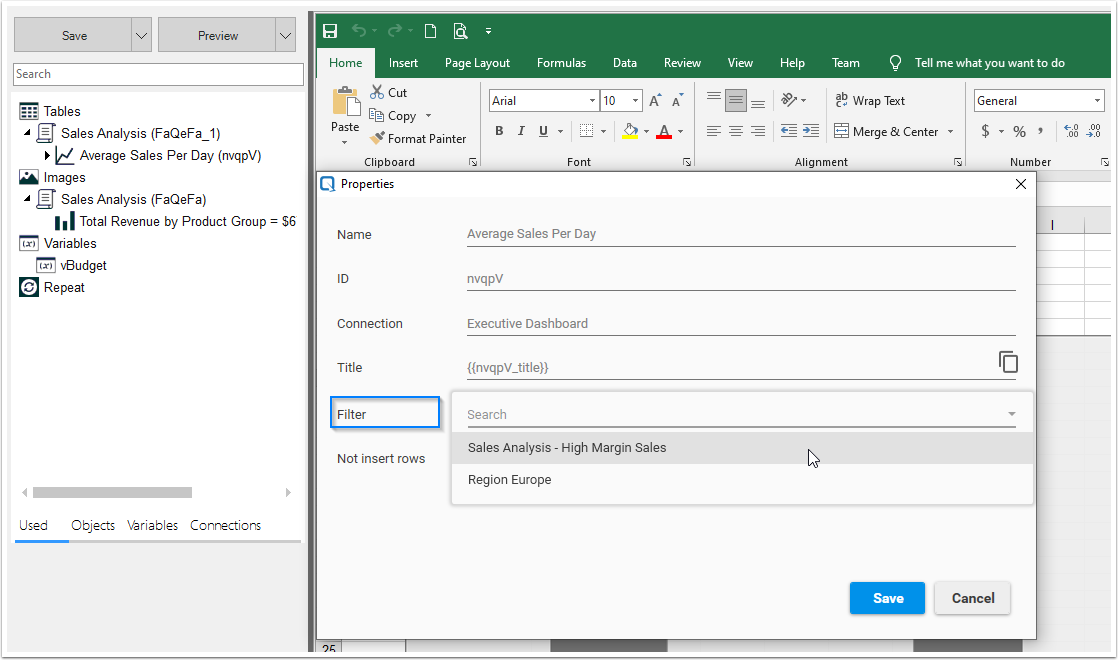
Choose image quality
You can customize the image quality for each object exported as an image.
By default, when an object is selected as an image, its quality is set to Inherited, meaning it will follow the quality settings defined at the report level. If an object's image quality is set to a specific value other than Inherited, that value will take precedence during report generation.
Image Quality Options:
- Standard: 144 DPI. A universal setting compatible with all object types.
- Optimized: 92 DPI. Designed for reduced file size while maintaining clarity.
- Medium: 150 DPI. Provides a balanced resolution for most use cases.
- High: 300 DPI. Offers the best quality, ideal for print-ready documents.
To change the image quality of an object, follow these steps:
- Go to the Used tab.
- Right-click on the object you want to modify.
- Select Properties from the context menu.
- In the Properties window, choose the desired Image Quality option.
- Click Save to apply the changes.
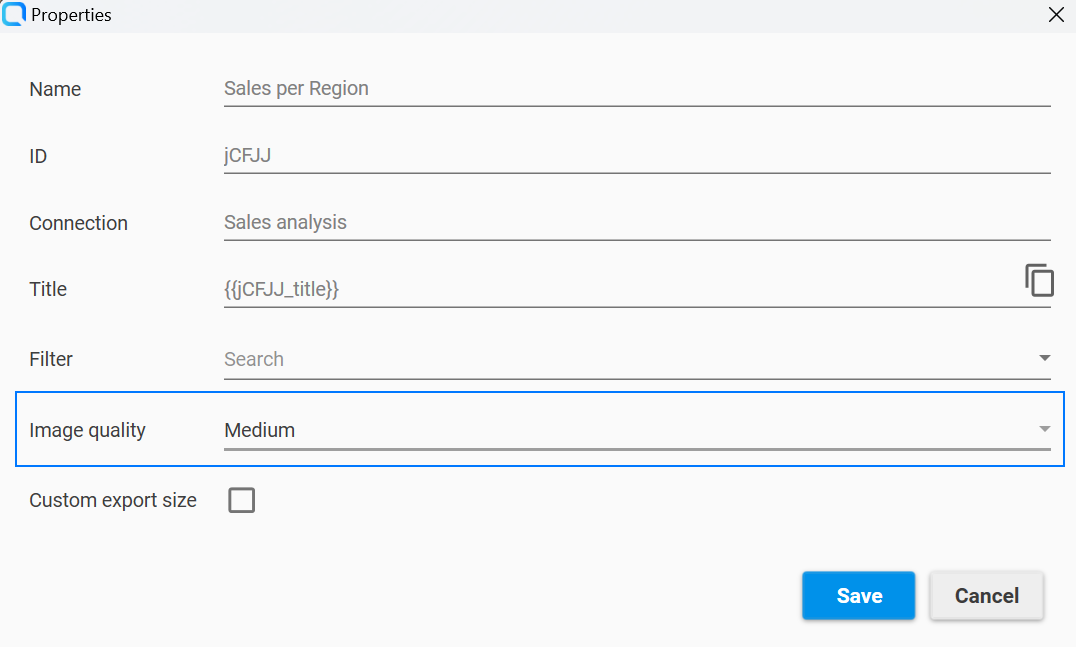
If the export fails at Optimized, Medium or High quality, Qalyptus will automatically attempt to export the object using Standard quality.
Third-party objects (extensions) and sheets exported as images will always use Standard image quality. It is not possible to select another option for these items.
Not insert new rows
When you use a table, Qalyptus, by Default, inserts new rows to keep the same layout of your different objects. But in some cases, you may want Qalyptus not to insert rows, for example, when you have several objects next to each other.
You have the option of not inserting rows when exporting a table.
Right-click on a table or pivot table object, then select Properties. In the Properties screen, check the checkbox, Not insert rows.
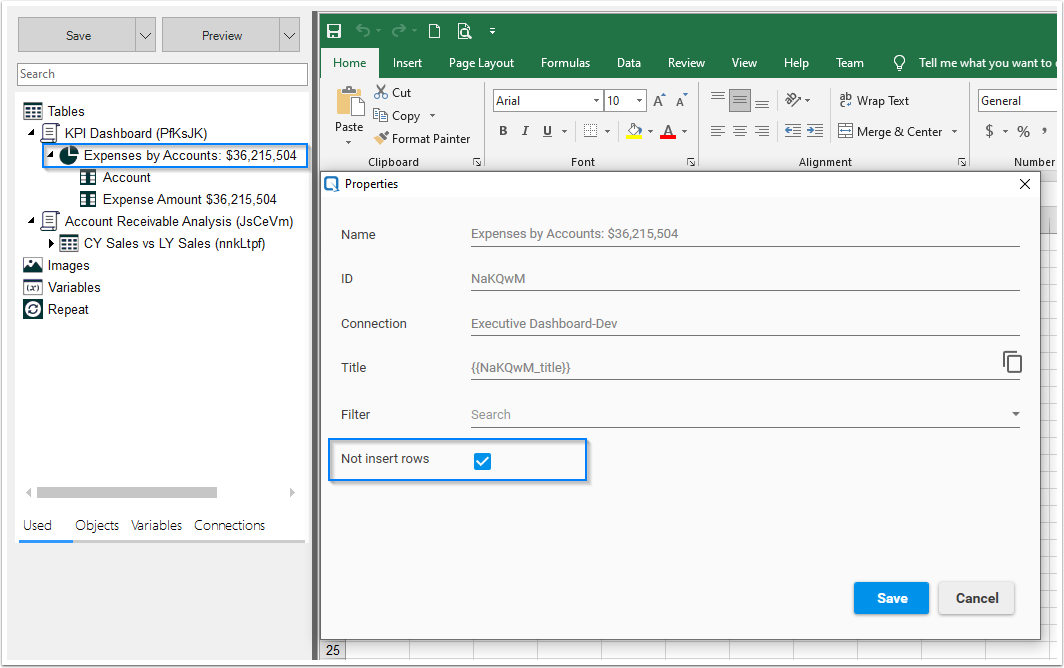
Choose pivot table rows presentation
You can choose how you want to export a pivot table. You have the choice between Default (the settings selected in Qlik Sense), Extend all, or Collapse all.
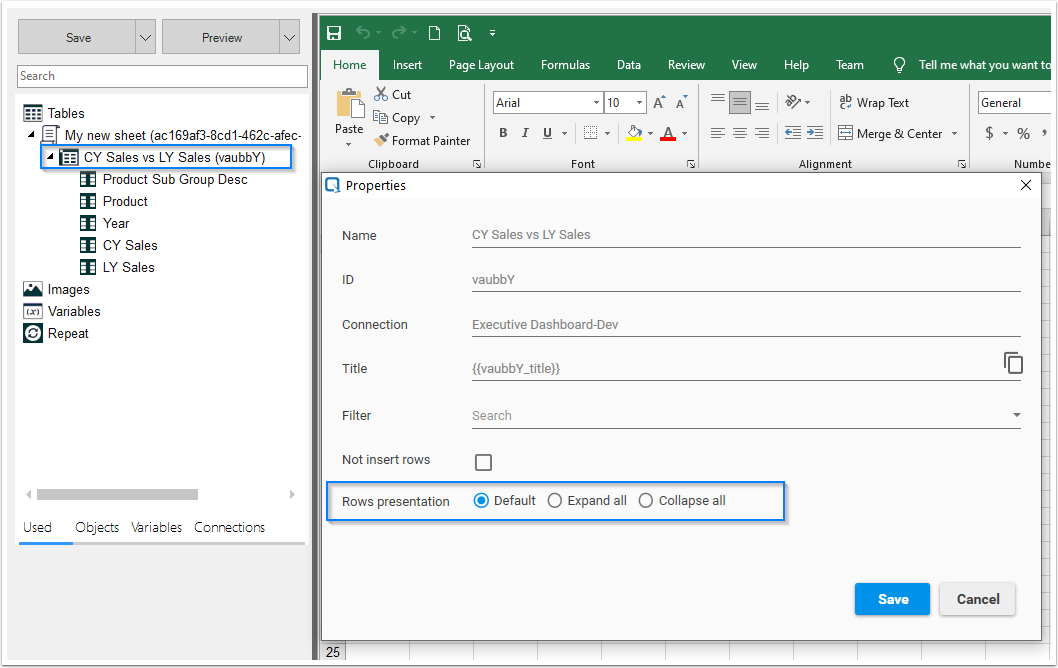
Export an object with a different size
This feature allows you to export a Qlik Sense object as an image with a size different from how it is used in the template file.
When you add a Qlik Sense object (chart or table) as an image in your report template, simply drag and drop the object into the template. Qalyptus creates a placeholder image that you can resize within the template. During report generation, Qalyptus exports the Qlik Sense object at the size of the placeholder image and places it accordingly in the report.
You can choose to export the image at a larger or smaller size than its usage in the template. For instance, you can export an image at 1200 x 800 px and use it in the template at 1000 x 600 px. This flexibility allows you to adjust the appearance of images in your report while maintaining high-quality exports.
To choose a custom export size, do the following:
- Go to the Used tab.
- Right-click on the object you want to modify.
- Select Properties from the context menu.
- In the Properties window, select the option Custom export size, then enter the Height and Width value. The default values represent the estimated size of the object as it appears in the Qlik Sense app.
- Use the Maintain Proportions option to ensure the image retains its original aspect ratio when you adjust either the width or height.
- Click Save to apply the changes.
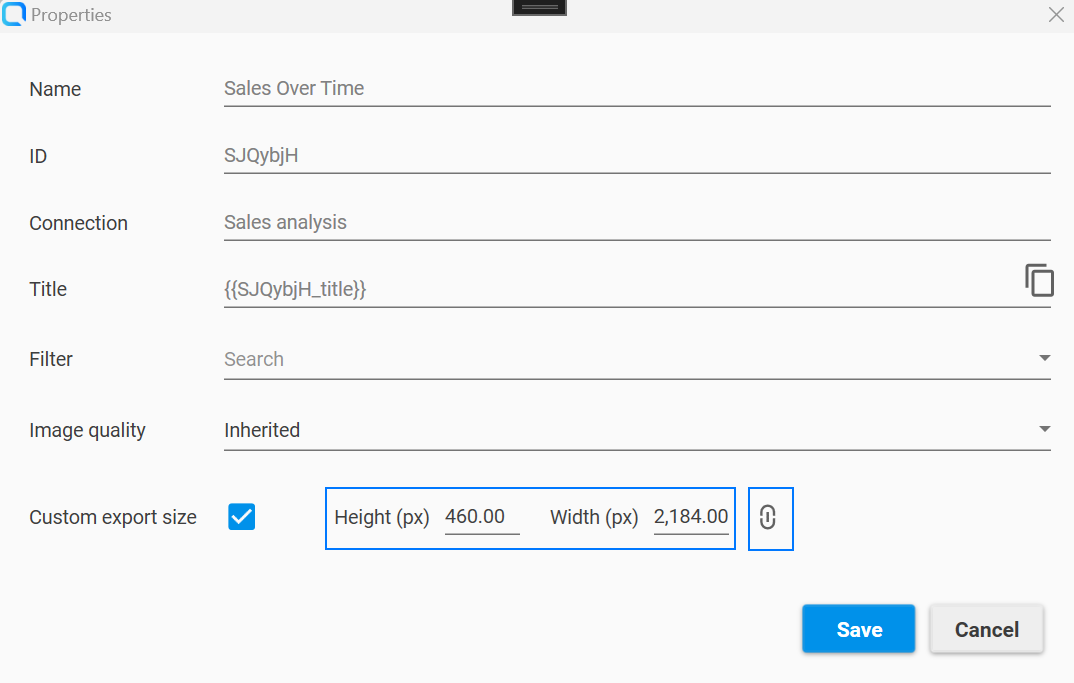
Exporting an object at a larger size ensures that you capture more details. This is particularly useful because Qlik Sense may hide certain information when the object's size is reduced.
Chart with a small size (export size = size of use )
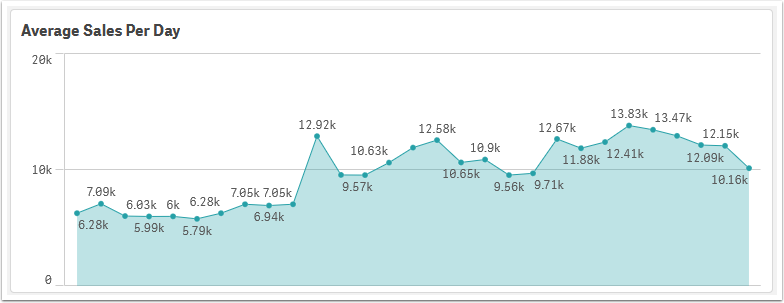
The same chart with a large export size (export size > size of use )
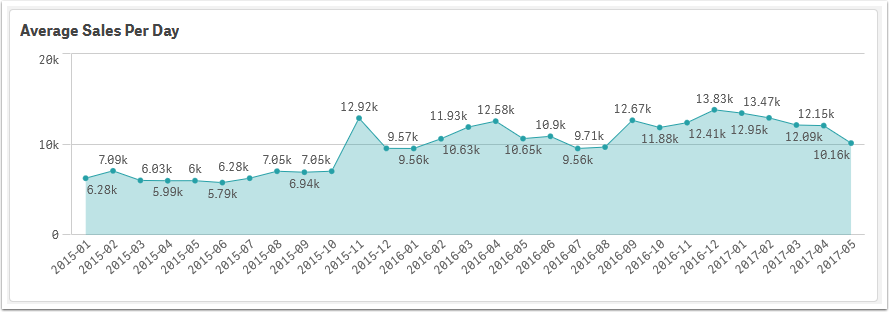
Create native Excel PivotTable
Qalyptus allows you to generate native Excel PivotTables in your reports using data exported from a Qlik Sense table.
To create a PivotTable, follow these steps.
-
Insert Qlik Sense table columns into your Excel template
In your Excel template:- Drag and drop individual columns from your Qlik Sense table into a worksheet.
- Do not drag and drop the whole object tag — this is not supported for PivotTables.
-
Important: Column headers must not contain Qalyptus tags
The header row of your data source must not contain any Qalyptus tags (such as{{Sales_label}}).
For example, use:Salesinstead of{{Sales_label}}. -
Add an empty row at the end of the data source range
To ensure the PivotTable works correctly during report generation, include an empty row after your data. -
Create the PivotTable
- Select the data range (including the empty row).
- Go to
Insert→PivotTable. - Place the PivotTable on a new worksheet or in the same one.
-
Configure the PivotTable
Use Excel's PivotTable options to define your rows, columns, filters, and values as needed. -
Preview Click the Preview button to see the result.
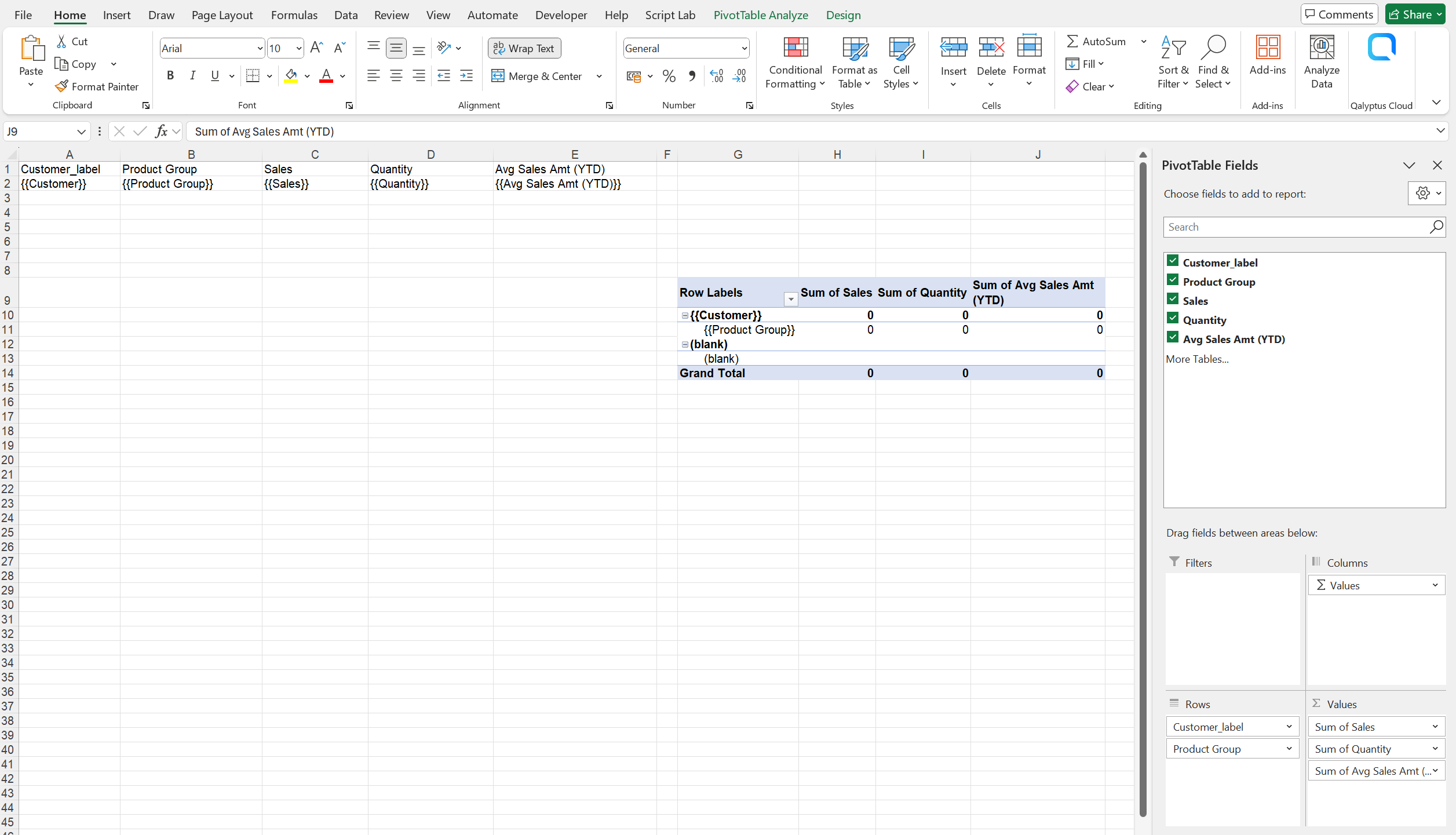
You can hide the sheet that contains the PivotTable’s data source to keep your final report clean and focused on the result.
Export Images and URLs in Excel Reports
Qalyptus supports exporting URLs and images from Qlik Sense tables into Excel and PDF reports.
- For URLs, use the Excel formula
HYPERLINK()to transform plain URLs into clickable hyperlinks in Excel and PDF reports. - For images, use the Excel formula
IMAGE()to display them inside Excel cells and make them visible in generated reports.
The source parameter in the HYPERLINK() and IMAGE() functions must reference a cell within the table that will contain a URL once the report is generated. You can hide this column for better clarity.
Using formulas gives you more control over how hyperlinks appear and how images are sized within cells.
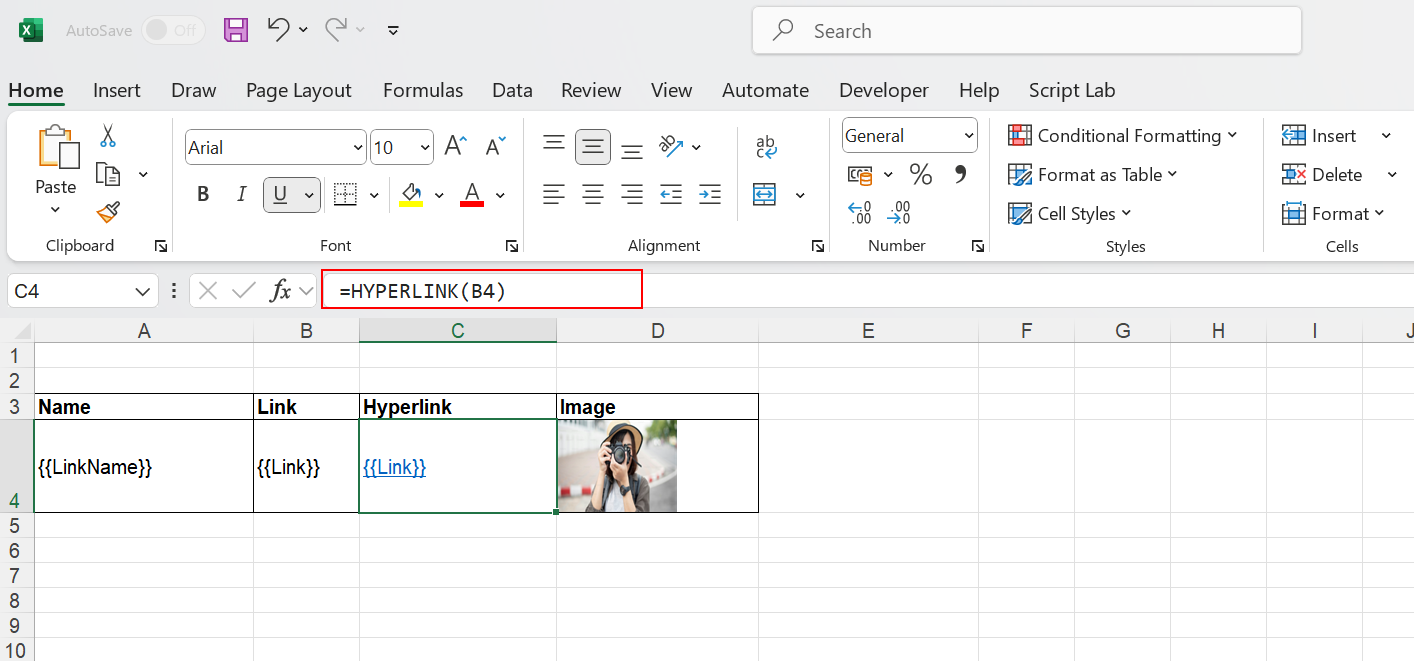
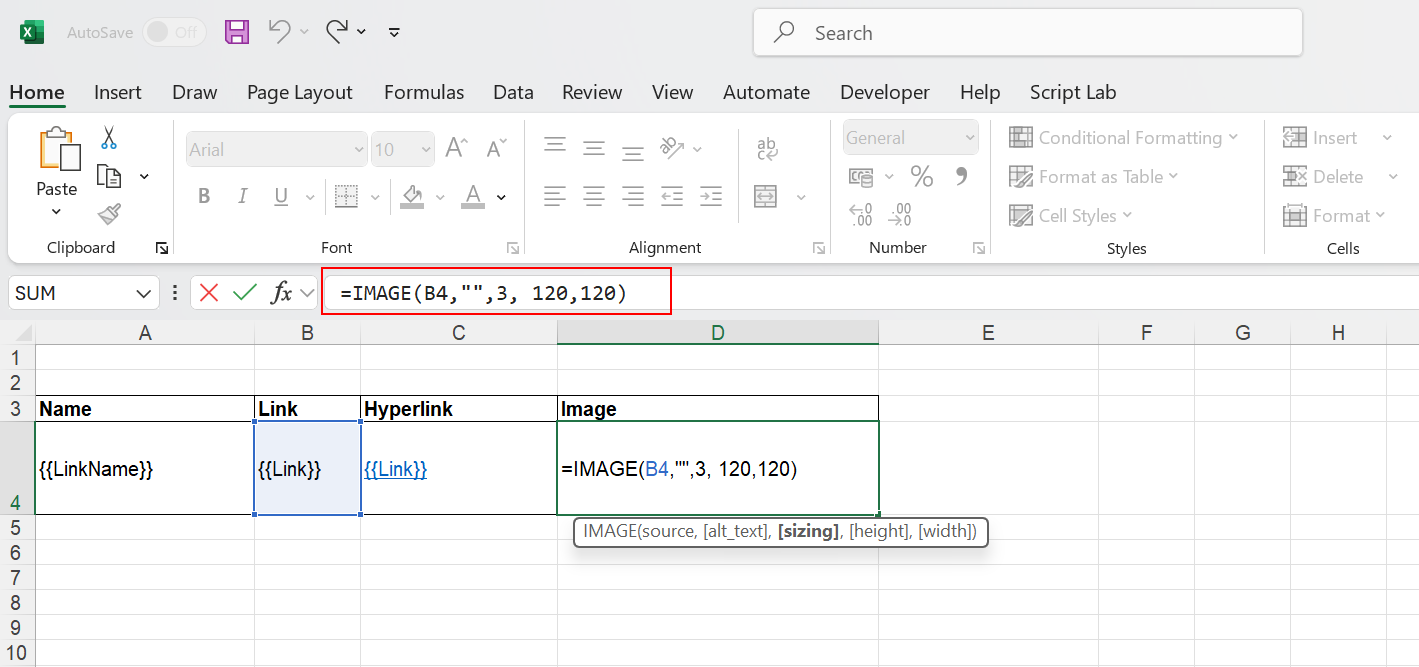
You can hide the column that contains the hyperlink or image source URL.
Use Excel formulas
Qalyptus supports formulas on columns — for example, calculating totals using SUM().
To use a formula, you need to include at least the data cell and one additional cell, as shown below.
The row containing the additional cell can be hidden to keep the report clean and professional.

You can also apply formulas on rows.
For instance, you can calculate the Average Price per Unit using the formula: Sales / Quantity.
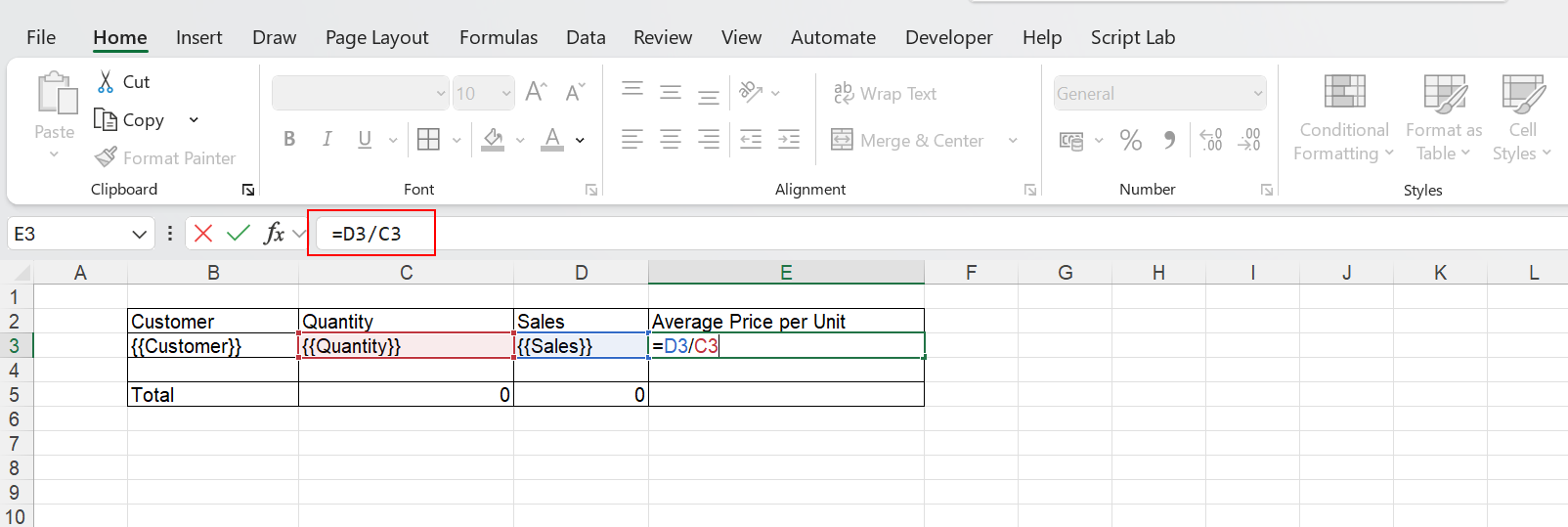
Formulas on rows must be placed in columns that are directly adjacent to the table columns.
Repeat on same sheet or across multiple sheets
You can repeat charts and tables on the same sheet or create a new sheet for each value of a dimension. Qalyptus makes it easy to repeat data by dimension in a report, allowing you to include repeated images, tables, and variables.
Key Features:
- Repeat Objects on a Single Sheet: Display Qlik Sense objects in a cell range multiple times on the same sheet, with each instance corresponding to a specific field value.
- Repeat Sheet Contents: Duplicate the contents of a single sheet for each value in a specified dimension field.
- Nested Repeats: Create complex, hierarchical reports by nesting repeat levels as many times as needed, providing flexibility for advanced reporting scenarios.
See how you can do it.
Repeat table header row across pages for a PDF
To repeat the first row of column headers on all pages when you have a large and complex worksheet, drag and drop the columns of the table object then:
- In Excel, click the Page Layout tab
- In the Page Setup group, click Print Titles
- Under the Sheet tab, in the Rows to repeat at top field, click on the icon on the right.
- Select the row you wish to appear at the top of every page. Press the Enter key
- Then click OK
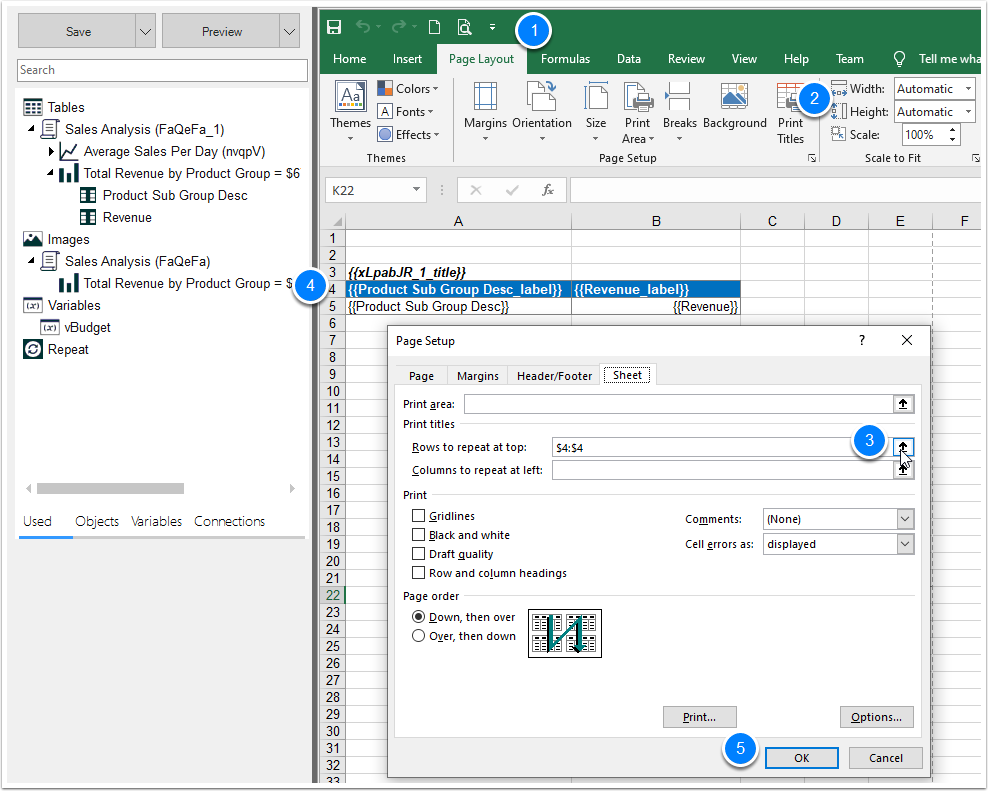
Here is the result:
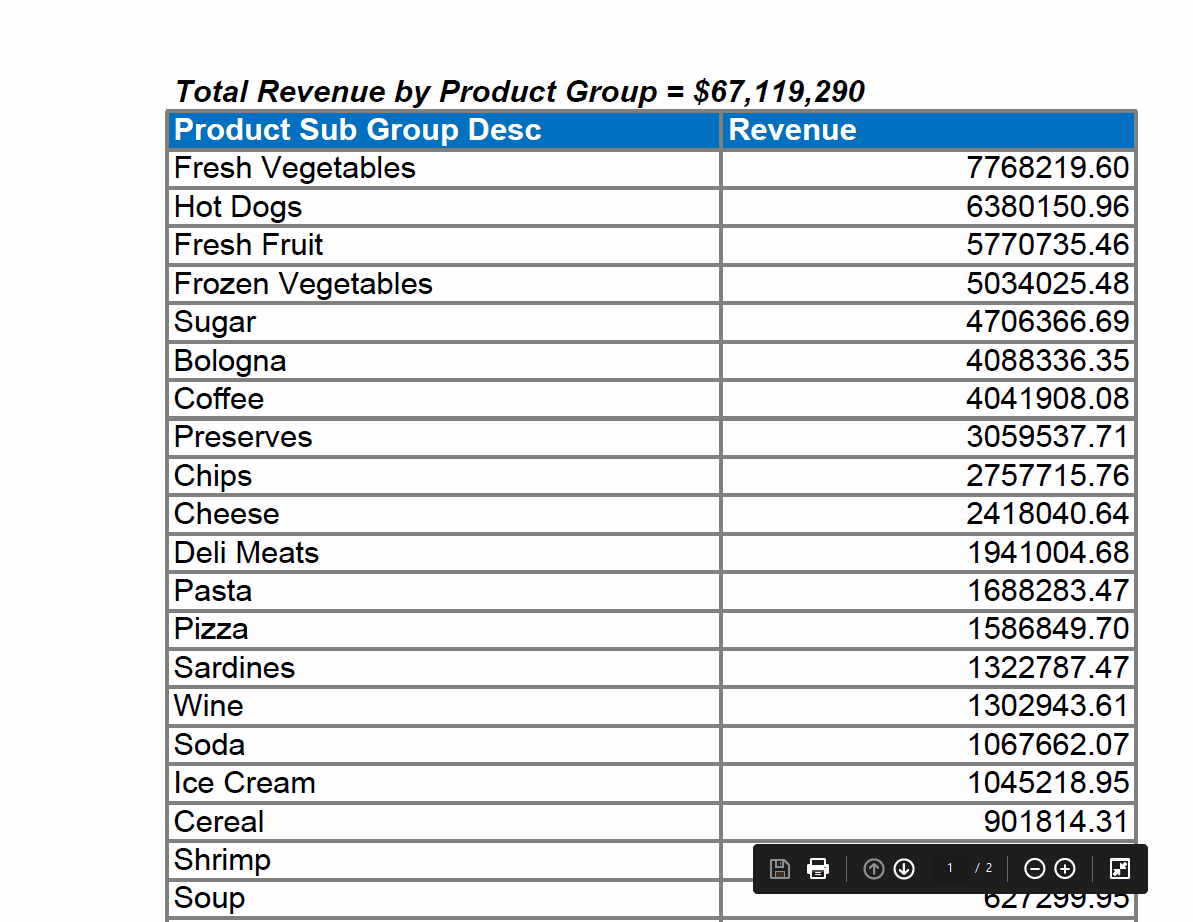
Template status
A template can have three different states:
- Valid template
- File not found
- No objects or variables used